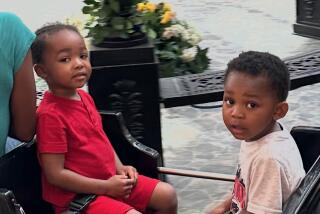Twins Separated in 22-Hour Operation
- Share via
In a 22-hour operation, a team of UCLA surgeons Tuesday separated 1-year-old twins who had been conjoined at the head, an operation that drew attention from Los Angeles to the infants’ hometown in Guatemala.
Doctors at UCLA’s Mattel Children’s Hospital said that the surgery went well, but that it will be at least a week before Maria Teresa and Maria de Jesus Quiej Alvarez are out of danger.
“They’re through the critical phase,” Dr. Michael Karpf, director of UCLA Medical Center, said after the separation was completed. He said the surgery “was the first major step, and it was really quite successful.”
But at 9:17 a.m. Tuesday, Maria Teresa was rushed back to the operating room to relieve pressure on her brain caused by a hematoma, a pooling of blood under the scalp.
After five more hours of surgery, the pressure had been reduced, and the surgeons said she was recovering well. Doctors are not sure what caused the hematoma.
“The situation will remain life- threatening for both the twins for several days,” Karpf said.
Dr. Jorge Lazareff, the pediatric neurosurgeon who coordinated the separation of Maria Teresa and Maria de Jesus, said, “When they smile back to us, then we’ll know they’re back to normal.”
Plastic surgeon Henry Kawamoto said doctors were too busy during the surgery to take note of the dramatic moment at which the actual separation occurred.
“It was not a celebratory experience,” he said. “The separation occurred, and we just went on to the next step. It wasn’t like we were all drinking champagne and crying and laughing. This was a planned operation. It was planned well and executed well. And this was just the next step.”
After Maria Teresa’s additional surgery to relieve the hematoma, she was taken to the same room as her sister in the pediatric intensive care unit. Both are anesthetized and breathing with the help of a respirator.
The surgery was the talk of the girls’ hometown, where residents held candlelight vigils at churches and raised money for the twins’ parents.
“We’re watching the news [on television] and listening to the radio,” said Ricardo Figueroa, an official from Santo Domingo Suchitepequez, a regional center near Aldea Belen, the impoverished coastal town where the family lives.
“When they come back, we’re going to give them a big party, with lots of presents.”
In June, an international medical charity, Healing the Children, brought the Guatemalan infants, who shared a skull and some important blood vessels and faced in opposite directions, to Los Angeles.
The twins came to UCLA with their mother, Alba Leticia Alvarez. Their father, Wenceslao Quiej-Lopez, joined them Saturday.
After conducting several neurological tests, physicians and surgeons confirmed that separation was feasible but risky.
The twins entered the operating room at 7:53 a.m. Monday. A reconstructive surgeon made the initial incisions at 1:49 p.m. to create skin flaps he would later need to cover the defect in their skulls. In the end, he had to use some grafts from their scalp to avoid leaving any brain exposed.
The twins were separated at 12:56 a.m. Tuesday, and doctors immediately began reconstructing the girls’ scalps. The surgery was completed at 5:40 a.m.
Maria Teresa, whose hematoma forced her return to the operating room less than four hours later, experienced considerable blood loss during the separation surgery but it was unclear if that had anything to do with the hematoma, said Dr. Swati Patel, one of the three pediatric anesthesiologists involved in the case
Patel said Maria de Jesus used only about five units of blood, but Maria Teresa required at least 19.
Juan Lopez, a cousin of the twins’ father, said that after the surgeries were over, the girls’ parents visited a nearby church.
“They went to thank God everything is OK,” he said.
Lazareff said he is not sure what, if any, subsequent problems might arise. “It depends on the types or areas of brain damage that might have occurred,” he said.
Kawamoto said that the surgery left the girls’ heads somewhat misshapen, but that subsequent plastic surgery could correct that.
“The goal was to get them separated,” he said.
More than 50 UCLA staff members were involved in the operation. The physicians and surgeons donated their services. UCLA hopes to recoup the cost of the twins’ care, estimated at $1.5 million, through contributions to a fund set up in their name.
Healing the Children is collecting money as well.
Times staff writers Jessica Garrison and Eric Malnic and Times wire services contributed to this report.
More to Read
Sign up for Essential California
The most important California stories and recommendations in your inbox every morning.
You may occasionally receive promotional content from the Los Angeles Times.












